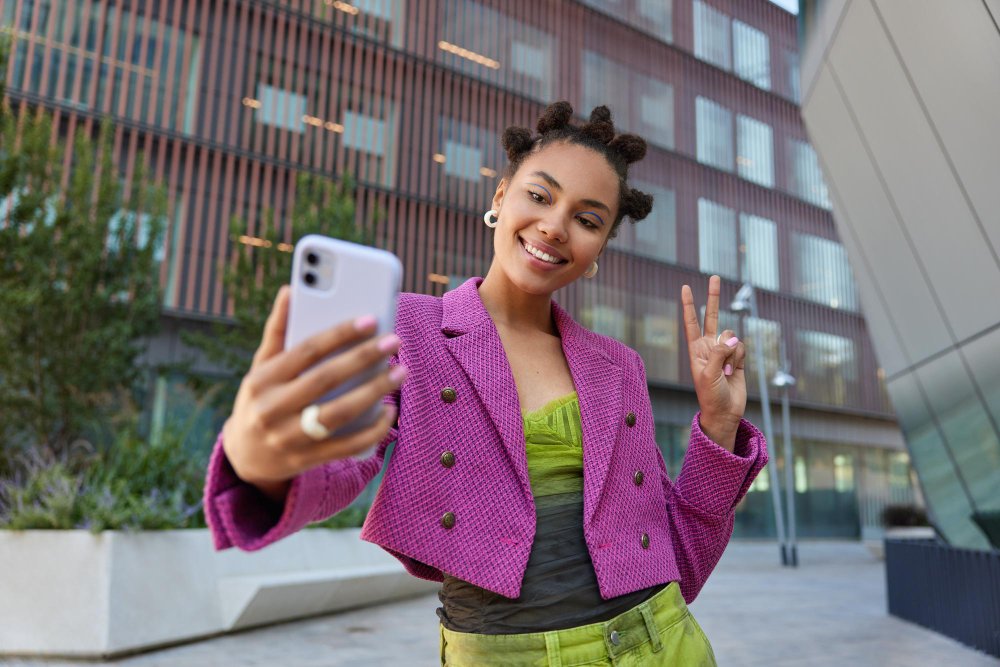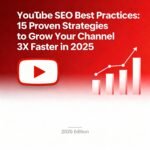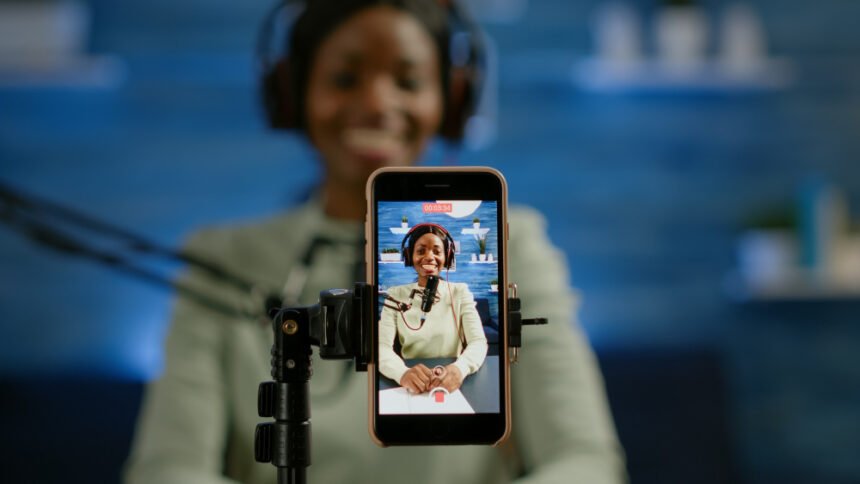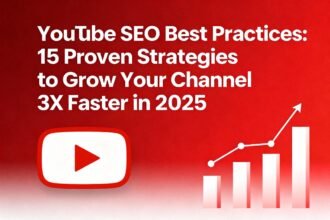Ever scrolled past another glossy, overproduced ad and barely blinked? You’re not alone. Consumers are tuning out traditional marketing faster than you can say “skip ad.” We’re in an age of digital fatigue—endless banner blindness, algorithm changes, and cold, impersonal campaigns that don’t feel like they understand the people they’re targeting.
So what cuts through the noise?
Influencers.
Real people with real voices and real communities who actually influence the decisions their followers make. Whether it’s a beauty tutorial on TikTok, a lifestyle vlog on YouTube, or a product review on Instagram Stories, influencers are the trusted bridge between brands and audiences. And if you’re asking “What is the role of influencers in social media marketing?”—the short answer is: they’re the new media power players.
But that’s just scratching the surface.
Influencers don’t just “post and pray.” They build trust, ignite engagement, and deliver ROI that traditional ads can only dream of. They’re creative storytellers, cultural connectors, and market movers. And as consumers grow more skeptical of branded messages, the need for authentic voices—not polished taglines—is more urgent than ever.
In this publication, we’ll break down exactly what the role of influencers in social media marketing is—from types of influencers to the strategic advantages they bring. You’ll get real-world stats, actionable tips, and the inside scoop on how the smartest brands are turning collaborations into conversions.
Who Exactly Are Influencers—and Why They Matter
So—what is the role of influencers in social media marketing at its core?
Before we get tactical, we need to get clear on who influencers are—and more importantly, why they hold power. These aren’t just selfie-posting content machines. Influencers are relationship builders, micro-communicators, and trusted advisors to their communities.
They’re not just promoting products; they’re shaping culture.
Also Read: What Are the Best Social Media Platforms for Marketing?
Whether it’s a makeup artist with 50,000 loyal YouTube subscribers or a tech-savvy dad sharing gear reviews with a small Twitter tribe, influencers earn their audience’s trust—and that trust translates into serious marketing firepower.
Influencers = Social Proof on Steroids
People trust people. Especially those who look like them, sound like them, and live like them.
According to Influencity: “83% of people are more likely to trust a recommendation from an individual influencer than from a brand.”
This is the difference between seeing a perfume ad on a billboard—and having your best friend tell you it smells incredible. The second hits differently, right?
The Platforms Where Influence Happens
Influencers thrive on the platforms their audiences use most:
- Instagram – Visual storytelling, product placements, lifestyle content.
- TikTok – Viral short-form videos, challenges, authentic unfiltered content.
- YouTube – Deep dives, reviews, tutorials, day-in-the-life vlogs.
- X (formerly Twitter) – Thought leadership, hot takes, niche communities.
- LinkedIn – B2B thought leadership, founder branding, product breakdowns.
- Pinterest – Visual inspiration, shoppable boards, evergreen content.
These platforms aren’t just content channels—they’re trust economies, and influencers are the high-value players within them.
Influencers Are the Evolution of Word-of-Mouth
You’ve heard it before: word-of-mouth is the most powerful form of marketing.
Well, influencer marketing is word-of-mouth at scale—amplified by technology, curated with precision, and laser-focused on specific demographics.
This leads to the golden question again:
What is the role of influencers in social media marketing?
They make your brand feel human. They get people talking, sharing, tagging, commenting, and—ultimately—buying.
4 Different Types of Influencers and When to Use Each One
So far we’ve explored what is the role of influencers in social media marketing from a high level. Now it’s time to zoom in. Because understanding the right type of influencer for your brand is like choosing the right tool for the job.
1. Mega-Influencers (1M+ Followers)
Think: Celebrities, reality stars, pop culture icons.
Examples: Kylie Jenner, Cristiano Ronaldo, Chioma Goodhair.
Best for:
- Explosive visibility
- Mass-market brand awareness
- Major product launches
- Luxury or aspirational branding
Cost: Extremely high (we’re talking $10k+ per post, often more)
Watch out for: Lower engagement rates and less authenticity
Strategic Tip: Use mega-influencers when your goal is visibility at scale—not deep niche targeting.
2. Macro-Influencers (100K – 1M Followers)
Think: Industry thought leaders, creators with large followings but less mainstream fame.
Examples: Tech YouTubers, wellness coaches, fashion bloggers.
Best for:
- National campaigns
- Driving traffic to branded content
- Event promotion
- Influencer-led product collaborations
Balance of reach and engagement—but still pricey
Often seen as aspirational yet relatable
Ideal when you want to blend trust with top-of-funnel awareness.
3. Micro-Influencers (10K – 100K Followers)
Here’s where things get spicy.
Micro-influencers are the sweet spot for most brands. They usually focus on a niche (fitness, tech, parenting, food, crypto—you name it), and their followers see them as experts or peers.
Best for:
- Authentic brand storytelling
- Higher engagement rates (4–8% vs. <2% for megas)
- Product reviews, tutorials, live demos
- Conversion-oriented campaigns
Stat: 67% of marketers report higher ROI working with micro-influencers compared to larger personalities.
Also Read: What Are the Best Social Media Platforms for Marketing?
These folks are often open to brand partnerships, giveaways, UGC campaigns—and won’t blow your budget.
4. Nano-Influencers (1K – 10K Followers)

Small followings, big loyalty. Nano-influencers often have hyper-local or community-based audiences and off-the-charts engagement.
Best for:
- Local business campaigns
- Hyper-niche products
- Grassroots community engagement
- UGC collection for repurposing
Very affordable, often in exchange for product
Great for building trust at the micro-level
Use nano-influencers when you’re launching in a new location, targeting micro-segments, or testing messaging.
Quick Comparison Snapshot
| Type | Follower Range | Engagement | Cost | Best Use-Case |
| Mega | 1M+ | Low | Very High | Mass brand awareness |
| Macro | 100K–1M | Med | High | National/international campaigns |
| Micro | 10K–100K | High | Moderate | Niche targeting & conversions |
| Nano | 1K–10K | Very High | Low | Local activations & grassroots trust |
So, what is the role of influencers in social media marketing at this stage?
It’s about pairing the right influencer tier with your campaign goals. Are you aiming for reach, relevance, or revenue? That choice defines who you work with—and how much you win.
What is The Role of Influencers in Social Media Marketing? Here Are 6 Core Functions
Now that we know who influencers are and how they vary, let’s get crystal clear on what they actually do for your brand.
Because the question isn’t just “what is the role of influencers in social media marketing?”—it’s why does it work so damn well?
Here’s the breakdown:
1. Trust & Authenticity Amplification
At the heart of it all: trust.
Influencers operate on a different frequency than traditional marketing. When a creator shares a product they love, it’s not a billboard or a sales script—it’s a personal recommendation.
According to Nielsen, 92% of consumers trust influencers more than brand ads.
That’s not a marketing trend—that’s a consumer trust revolution.
And here’s the kicker: this authenticity doesn’t scale easily through ads. But it does through influencers who’ve spent years building loyal communities.
2. Expanding Brand Awareness—Fast
Want your product to get discovered without spending a million on TV ads?
Influencers can deliver that big reach energy—fast.
Especially when you pair with macro- or mega-influencers, you unlock massive brand exposure. Even better, micro- and nano-influencers can give your brand a grassroots push, introducing it to communities you’ve never touched before.
Stat: Influencer marketing campaigns on Instagram alone reach over 1.3 billion users per month globally.
This isn’t just a numbers game—it’s a targeted awareness engine.
3. Driving Engagement, Traffic & Conversions
What’s the point of awareness if nobody clicks?
Here’s where influencers flex their real value: engagement that drives action.
Their audiences don’t just like—they comment, share, DM, swipe up, and buy.
In fact:
Micro-influencer campaigns generate up to 60% more engagement than traditional ads.
Influencers create content that starts conversations and moves people to act. Whether it’s a link in bio or a “use my code” CTA, their content funnels traffic to your site—and then to your cart.
4. Targeted Niche Marketing at Its Finest
You want to reach dog moms in Austin who love organic treats? There’s an influencer for that.
Tech nerds in Nairobi? Covered.
Gen Z skincare junkies who follow cruelty-free trends? Done.
Influencers are micro-niche masters. Their followings are tight-knit and interest-specific—which means your message goes straight to your ideal customer.
According to Sprout Social, brands working with niche influencers see 2x the conversion rates of broader campaigns.
5. Influencers as Content Creators (Not Just Distributors)
Another often-overlooked gem? These folks are incredible content creators.
They understand lighting, trends, hooks, formats, and tone better than most brand marketers. When you partner with them, you’re also getting content you can:
- Repost to your feed
- Use in paid ads
- Add to your website or email flows
It’s user-generated content (UGC) meets studio-level storytelling—with authenticity baked in.
6. Long-Term Brand Partnerships Build Loyalty
Want lasting brand equity? Don’t ghost your influencers after one post.
The smartest brands build ongoing partnerships that evolve from campaigns into collaborations—and eventually, into brand ambassadorships.
These long-term relationships lead to:
- More authentic storytelling
- Deeper audience trust
- More effective campaigns over time
So…
What is the role of influencers in social media marketing?
They’re the strategic link between people and products, trust and tech, brand awareness and buyer behavior.
Industry-Proven Stats That Seal the Deal
If you’re still wondering, “What is the role of influencers in social media marketing?”—here’s the cold, hard proof that it’s a revenue-driving machine.
We’re talking multi-billion dollar industry growth, skyrocketing ROI, and rising adoption across every vertical from fashion to fintech. Influencers aren’t a side strategy—they’re becoming the core of performance-driven social marketing.
Let’s look at the numbers:
Influencer Marketing Is a Global Juggernaut
$32.55 billion — That’s the projected global value of the influencer marketing industry by end of 2025.
(Source: Influencer Marketing Hub)
That’s not a trend. That’s a movement.
Marketers Are Going All-In
86% of US marketers say they will partner with influencers in 2025.
(Source: Sprout Social, [6])
And over 80% of marketers across all industries say influencer marketing is highly effective.
Why? Because it blends visibility, relatability, and conversion in one neat package.
Micro-Influencers = Major ROI
67% of marketers say micro-influencers deliver better ROI than traditional digital campaigns.
(Source: Influencity, [2])
Why? Because micro-creators bring:
- Higher engagement
- Targeted reach
- More authentic storytelling
For brands looking to grow on a budget, this is the playbook.
Platform Power Rankings
Top platforms for influencer marketing:
- Instagram — 77% of brands run influencer campaigns here
- TikTok — Fastest-growing platform, especially for Gen Z
- YouTube — Best for evergreen content and SEO juice
(Sources: Sprout Social [6], DMI [9], Influencer Hub [8])
But don’t sleep on LinkedIn for B2B or Pinterest for evergreen niche content like DIY, food, and wellness.
Brands That Use Influencers See Results Like…
- 11x higher ROI than traditional banner ads
- 3x the conversion rate compared to paid media without influencer touchpoints
- 50% better retention rates when UGC is used in email and ad campaigns
(Sources: Cure Media [4], Sprout [7], Shopify [15])
And this is just the beginning. With the rise of AI-powered influencer discovery tools, real-time campaign analytics, and performance-based contracts, influencer marketing is becoming more precise and profitable than ever.
Bottom line?
What is the role of influencers in social media marketing?
They’re not just part of the strategy—they’re often the top-performing channel in it.
6 Ways to Maximize Influencer Marketing Results
You’ve nailed down what is the role of influencers in social media marketing—now let’s talk execution. Because hiring an influencer and hoping for magic? That’s a rookie move.
The best-performing campaigns are strategic, collaborative, and data-driven. Here’s how to turn likes and shares into leads and sales:
1. Choose the Right Influencer
Forget chasing big numbers. Focus on fit over followers.
Ask:
- Does their audience overlap with your ideal buyer?
- Does their tone, aesthetic, and content style align with your brand?
- Do they actually engage with their community?
Tip: Tools like Influencity, AspireIQ, and Heepsy can help you analyze engagement rates, fake follower audits, and audience demographics.
2. Prioritize Authenticity Over Vanity Metrics
You don’t need a supermodel with 5 million followers. You need a content creator whose followers trust their opinion.
The smartest brands now co-create:
- Unboxing videos
- Behind-the-scenes reels
- “A day in the life” stories featuring products in real use
This doesn’t feel like an ad. It feels like lifestyle. That’s the magic.
3. Track Performance Like a Pro
If you’re not measuring, you’re just guessing. Period.
Track:
- Engagement rate (likes, comments, shares, saves)
- Referral traffic (use UTM links + Google Analytics)
- Conversion rate (with influencer discount codes or landing pages)
- Earned media value (EMV)
Stat: Brands that use influencer tracking tools see 35% higher ROI on average.
(Source: Sprout Social, [7])
4. Think Beyond One-Offs—Build Relationships
One-time posts are fine. But brand loyalty comes from long-term partnerships.
Why it works:
- Builds consistency = recognition = trust
- Evolves from “sponcon” to genuine brand love
- Influencer becomes a true ambassador, not just a contractor
Try:
- Multi-post packages
- Quarterly collabs
- Exclusive partnerships
Brands that invest in long-term influencer relationships report up to 60% higher customer retention.
(Source: Cure Media, [4])
5. Repurpose Influencer Content Across Channels
Don’t let great content die on their feed. Repurpose it across:
- Your Instagram or Facebook pages (with permission)
- Website product pages
- Email campaigns
- Social ads
Stat: Using influencer-generated content in paid ads increases performance by up to 400% compared to studio-shot creatives.
(Source: DMI, [9])
This is how you stretch your budget—and scale authenticity.
6. Layer Influencer Marketing Into Your Full Funnel Strategy
Influencer marketing isn’t a silo—it should plug into your entire sales journey:
- Awareness (macro)
- Engagement (micro)
- Retargeting (UGC-powered ads)
- Conversions (exclusive codes + landing pages)
Map influencers to the customer journey. That’s how you build a revenue engine.
So again—what is the role of influencers in social media marketing?
They’re creators, connectors, and converters. But only when you know how to use them.
Final Thoughts: Why Influencers Are the Missing Link in Your Strategy
If there’s one thing this deep dive should make abundantly clear, it’s this:
Influencers are no longer “nice to have.” They’re essential.
In a world drowning in algorithm tweaks, ad blockers, and consumer skepticism, traditional marketing tactics are losing their punch. The brands that are thriving in 2025? They’re the ones tapping into real voices, real people, and real trust.
So when you ask, “What is the role of influencers in social media marketing?”—the answer is:
They’re the trust layer your marketing stack has been missing.
They’re the creative force driving virality, engagement, and conversions.
They’re the ROI-multipliers transforming attention into action—and influence into income.
Here’s What Influencers Bring to the Table
- Hyper-targeted reach
- Authentic storytelling
- Cultural relevance
- High-converting content
- Long-term brand loyalty
- Measurable ROI
Whether you’re a scrappy startup or a global enterprise, influencer marketing is the smartest, most scalable way to inject humanity into your digital presence.
The good news? You don’t need a celebrity budget. You just need the right strategy, alignment, and partnership.
So What Now?
- Audit your audience
- Find your influencer fit
- Start small, measure everything, iterate fast
Because the real question isn’t “What is the role of influencers in social media marketing?”—
It’s “How long can you afford to ignore them?”
Frequently Asked Questions
What is the role of influencers in social media marketing today?
Influencers play a crucial role by bridging the gap between brands and consumers through authentic content, personalized storytelling, and trust-based engagement. They help brands increase awareness, drive conversions, and connect with niche audiences on platforms like Instagram, TikTok, and YouTube.
Are influencers really more effective than traditional ads?
Yes—by a wide margin. Influencer content often generates up to 11x more ROI than traditional banner ads. Audiences engage more with real people than with corporate messaging, making influencers a better choice for trust and conversions.
What types of influencers should brands work with?
It depends on your goals:
- Mega-influencers: Best for mass visibility
- Macro-influencers: Great for national campaigns
- Micro-influencers: Ideal for engagement and niche markets
- Nano-influencers: Perfect for community building and hyper-targeted campaigns
How do I know if an influencer is right for my brand?
Check for:
- Audience alignment
- Engagement rate (aim for 3–8% depending on follower count)
- Content quality and authenticity
- Previous brand collaborations and campaign performance
How do I measure the success of an influencer campaign?
Track:
- Engagement (likes, comments, shares)
- Website traffic (UTM links)
- Sales (unique discount codes)
- Conversion rates and ROI through analytics tools
What is the future of influencer marketing?
The future is data-driven, niche-focused, and rooted in long-term collaborations. As social commerce grows and AI tools streamline targeting, influencer marketing is becoming smarter, faster, and more profitable than ever before.













